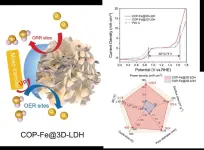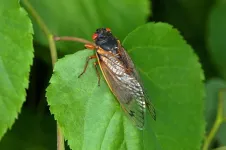(Press-News.org) In a first-in-human phase 1 trial in 41 patients with recurrent glioblastoma, an oncolytic virus treatment designed by Brigham researchers extended survival, especially among those with pre-existing viral antibodies
Therapy turns ‘immune desert’ into inflammatory cancer-fighting zone
Study demonstrated the safety and preliminary efficacy of a novel gene therapy for glioblastoma
Glioblastoma (GBM), an aggressive brain cancer, is notoriously resistant to treatment, with recurrent GBM associated with survival of less than 10 months. Immunotherapies, which mobilize the body’s immune defenses against a cancer, have not been effective for GBM, in part because the tumor’s surrounding environment is largely impenetrable to assaults from the body’s immune system. To convert this immunosuppressive environment into one amenable to an immune response, investigators from Brigham and Women’s Hospital, a founding member of the Mass General Brigham healthcare system, engineered a novel oncolytic virus that can infect cancer cells and stimulate an anti-tumor immune response. Results, published in Nature, demonstrated the safety and preliminary efficacy of the novel gene therapy approach in high-grade glioma patients, with prolonged survival in a subgroup of recurrent GBM patients immunologically “familiar” with the virus.
“GBM has an aggressive effect in part because of a milieu of immunosuppressive factors surrounding the tumor, which enable the tumor’s growth by preventing the immune system from entering and attacking it,” said corresponding author E. Antonio Chiocca, MD, PhD, Chair of the BWH Department of Neurosurgery. “This study showed that with a virus we designed, we can reshape this ‘immune desert’ into a pro-inflammatory environment.”
This phase I, first-in-human trial examined the safety of an oncolytic virus, called CAN-3110, which was designed and subjected to preclinical testing by researchers at BWH and licensed to Candel Therapeutics as the trial was ongoing.
The cancer-attacking virus is an oncolytic herpes simplex virus (oHSV), which is the same type of virus used in a therapy approved for the treatment of metastatic melanoma. Unlike other clinical oHSVs, this therapy includes the ICP34.5 gene, which is often excluded from clinical oHSVs because it causes human disease in unmodified forms of the virus. However, the researchers hypothesized that this gene may be necessary to trigger a robust, pro-inflammatory response necessary for attacking the tumor. Therefore, they designed a version of the oHSV1 that contains the ICP34.5 gene but is also genetically “programmed” not to attack healthy brain cells.
Overall, the trial demonstrated the safety of CAN-3110 in 41 patients with high-grade gliomas, including 32 with recurrent GBM. The most serious adverse events were seizures in two participants. Notably, GBM participants who had pre-existing antibodies to HSV1 virus (66% of the patients) had a median overall survival of 14.2 months. In patients with pre-existing antibodies, the researchers saw markers of several changes in the tumor microenvironment associated with immune activation. They hypothesize that the presence of HSV1 antibodies resulted in a rapid immune response to the virus, which brought more immune cells to the tumor and increased the levels of inflammation in the tumor microenvironment.
After CAN-3110 treatment, the investigators also observed an increase in the diversity of the T cell repertoire, suggesting that the virus induces a broad immune response, perhaps by eliminating tumor cells resulting in the release of cancer antigens. These immunological changes after treatment were also shown to be associated with improved survival.
Studies like this one show the promise of gene therapy for treating intractable conditions. Mass General Brigham’s Gene and Cell Therapy Institute is helping to translate scientific discoveries made by researchers into first-in-human clinical trials and, ultimately, life-changing treatments for patients. The Institute’s multidisciplinary approach sets it apart from others in the space, helping researchers to rapidly advance new therapies and push the technological and clinical boundaries of this new frontier.
Going forward, the researchers plan to complete prospective studies to further investigate the effectiveness of the oncolytic virus in patients who do and do not have antibodies to HSV1. Having demonstrated the safety of one viral injection, they are proceeding to test the safety and efficacy of up to six injections over four months, which, like multiple rounds of vaccination, may increase the effectiveness of the therapy. The new, six-injection trial is funded by Break Through Cancer.
“Almost no immunotherapies for GBM have been able to increase immune infiltration to these tumors, but the virus studied here provoked a very reactive immune response with infiltration of tumor-killing T-cells,” Chiocca said. “That’s hard to do with GBM, so our findings are exciting and give us hope for our next steps.”
Authorship: Co-first authors are Alexander L. Ling (BWH), Isaac H. Solomon (BWH), Ana Montalvo Landivar (BWH), and Hiroshi Nakashima (BWH). Mass General Brigham co-authors include Jared K. Woods (BWH), Andres Santos (BWH), Nafisa Masud (BWH), James Grant (BWH), Abigail Zhang (BWH), Joshua D. Bernstock (BWH), Erickson Torio (BWH), Hirotaka Ito (BWH), Junfeng Liu (BWH), Naoyuki Shono (BWH), Michal O. Nowicki (BWH), Daniel Triggs (BWH), Patrick Halloran (BWH), Raziye Piranlioglu (BWH), Himanshu Soni (BWH), Brittany Stopa (BWH), Wenya Linda Bi (BWH), Pierpaolo Peruzzi (BWH), Ethan Chen (BWH), Seth W. Malinowski (BWH), Michael C. Prabhu (BWH), Yu Zeng (BWH), Scott J. Rodig (BWH), L. Nicolas Gonzalez Castro (BWH), Sidney D. Dumont (MGH), Tracy Batchelor (BWH), Mario L. Suvà (MGH), and Keith Ligon (BWH).
Additional co-authors include Geoffrey Fell, Xiaokui Mo, Ayse S. Yilmaz, Anne Carlisle, Patrick Y. Wen, Eudocia Quant Lee, Lakshmi Nayak, MD, Ugonma Chukwueke, MD, Kara Kittelberger, Ekaterina Tikhonova, Natalia Miheecheva, Dmitry Tabakov, Nara Shin, Alisa Gorbacheva, Artemy Shumskiy, Felix Frenkel, Estuardo Aguilar-Cordova, Laura K. Aguilar, David Krisky, James Wechuck, Andrea Manzanera, Chris Matheny, Paul P. Tak, Francesca Barone, Daniel Kovarsky, Itay Tirosh, Kai W. Wucherpfennig, and David A. Reardon. E. Antonio Chiocca (BWH) is the paper’s corresponding author.
Disclosures: Chiocca is an advisor to Amacathera, Bionaut Labs, Genenta, inc., Insightec, Inc., DNAtrix Inc, Seneca Therapeutics, Theravir. He has equity options in Bionaut Laboratories, DNAtrix, Immunomic Therapeutics, Seneca Therapeutics, Ternalys Therapeutics. He is co-founder and on Board of Directors of Ternalys Therapeutics.
Patents related to oHSV and CAN-3110 are under the possession of Brigham and Women’s Hospital with Chiocca as a co-inventor. These patents have been licensed to Candel Therapeutics, Inc. Present and future milestone license fees and future royalty fees are distributed to BWH from Candel. A full list of authors disclosures can be found in the paper.
Funding: Funding for this study was provided by National Cancer Institute (P01 CA163205, P01 CA236749), National Institutes of Health (R01NS110942, 2T32CA079443, T32CA251062), The Sandra Jelin Plouffe Fund to Advance Glioblastoma Research, The Oligodendroglioma Fund, The Oppenheimer Tiger Fund, The Daniel E. Ponton Fund, The MIT Koch Institute Bridge Grant, Alliance for Cancer Gene Therapy, KDDI Foundation Scholarship, The Leukemia and Lymphoma Society 2322-19, Clinical Trial Regulatory Support (in-kind and financial) from Candel Therapeutics, Inc.
Paper cited: Ling, AL et al. “Clinical trial links oncolytic immunoactivation to survival in glioblastoma Nature DOI: 10.1038/s41586-023-06623-2
END
Researchers design gene therapy that can effectively target glioblastoma
In a first-in-human phase 1 trial in 41 patients with recurrent glioblastoma, an oncolytic virus treatment designed by Brigham researchers extended survival, especially among those with pre-existing viral antibodies
2023-10-18
ELSE PRESS RELEASES FROM THIS DATE:
From a five-layer graphene sandwich, a rare electronic state emerges
2023-10-18
Ordinary pencil lead holds extraordinary properties when shaved down to layers as thin as an atom. A single, atom-thin sheet of graphite, known as graphene, is just a tiny fraction of the width of a human hair. Under a microscope, the material resembles a chicken-wire of carbon atoms linked in a hexagonal lattice.
Despite its waif-like proportions, scientists have found over the years that graphene is exceptionally strong. And when the material is stacked and twisted in specific contortions, it can take on surprising electronic behavior.
Now, MIT physicists have discovered another surprising property ...
Treatment rates for mental disorders among children and adolescents
2023-10-18
About The Study: The results of this meta-analysis of 40 studies including 310,000 children and adolescents suggest that, in general, the treatment rates for mental disorders among children and adolescents were low, especially for depression and anxiety. Targeted intervention policies and effective measures should be designed and implemented to improve treatment rates of psychiatric disorders among youths.
Authors: Yuanyuan Xiao, Ph.D., of Kunming Medical University in Kunming, Yunnan, China, is the corresponding author.
To access the embargoed study: Visit our For The Media website at this link https://media.jamanetwork.com/
(doi:10.1001/jamanetworkopen.2023.38174)
Editor’s ...
Association of antepartum and postpartum air pollution exposure with postpartum depression in southern California
2023-10-18
About The Study: The findings of this study including 340,000 pregnant women suggest that long-term exposure to antepartum and postpartum air pollution was associated with higher postpartum depression risks. Identifying the modifiable environmental risk factors and developing interventions are important public health issues to improve maternal mental health and alleviate the disease burden of postpartum depression.
Authors: Jun Wu, Ph.D., of the University of California, Irvine, is the corresponding author.
To access the embargoed study: Visit our For The Media website at this link ...
Scientists uncover new way viruses fight back against bacteria
2023-10-18
A microscopic discovery will not only enable scientists to understand the microbial world around us but could also provide a new way to control CRISPR-Cas biotechnologies.
An international team of researchers led by Professor Peter Fineran from the University of Otago and Dr Rafael Pinilla-Redondo from the University of Copenhagen has published a study in the prestigious journal Nature revealing new way viruses suppress the CRISPR-Cas immune systems of bacteria.
Co-first author Dr David Mayo-Muñoz, of the Phage-host interactions (Phi) laboratory in ...
Single vaccine protects against three deadly strains of coronavirus
2023-10-18
DURHAM, N.C. – A vaccine designed to protect against three different deadly coronaviruses shows success in mouse studies, demonstrating the viability of a pan-coronavirus vaccine developed by researchers at the Duke Human Vaccine Institute.
Publishing in the journal Cell Reports, the single nanoparticle vaccine included components of a previous vaccine that was shown to protect mice and primates against multiple variants of SARS-CoV-2, which is the virus that causes COVID-19. In this study, the vaccine protected mice from SARS-CoV-1, another form of SARS coronavirus that can infect humans, and a MERS coronavirus that has led to periodic, deadly outbreaks ...
Milestone: Miniature particle accelerator works
2023-10-18
Particle accelerators are crucial tools in a wide variety of areas in industry, research and the medical sector. The space these machines require ranges from a few square meters to large research centers. Using lasers to accelerate electrons within a photonic nanostructure constitutes a microscopic alternative with the potential of generating significantly lower costs and making devices considerably less bulky. Until now, no substantial energy gains were demonstrated. In other words, it has not been shown that electrons really have increased in speed significantly. A team of laser physicists at Friedrich-Alexander-Universität Erlangen-Nürnberg ...
Simple MRI scan could predict radiation side effects for prostate cancer
2023-10-18
A new Corewell Health study suggests that men who have longer prostatic urethras, the part of the urethra that travels through the prostate, may be at a higher risk of experiencing moderate, often chronic urinary side effects after receiving radiation for prostate cancer.
To date, researchers have struggled to determine any risk factors that could shed light on who might experience these types of side effects ahead of time. But now, a simple MRI scan and a new metric to determine urethra length could change that.
Results, now published in the journal Academic Radiology, indicate that for every 1-centimeter increase in length of the prostatic ...
A newly hierarchically porous pyrolysis-free bifunctional catalyst to boost ultralong lifespan zinc-air batteries
2023-10-18
They published their work on Oct. 12 in Energy Material Advances.
"The development of cost-effective and high-performance zinc-air battery cathode catalyst is imperative," said paper author Zhonghua Xiang, professor with the Beijing University of Chemical Technology. "Currently, zinc-air batteries still not occupy the market, because they are limited in both stability and in their energy density."
Xiang explained that zinc-air batteries can only work for very limited time at high current density, because there are lots of problems of its cathode, anode and electrolyte.
"The air ...
Do adult periodical cicadas actually feed on anything?
2023-10-18
Annapolis, MD; October 18, 2023—Every so often, cicadas emerge above ground and blanket the earth with their exoskeletons while emitting a high-pitched chirp from sunrise to sunset. The periodical cicadas in the genus Magicicada come every 13 or 17 years, though other types of cicadas emerge much more frequently in our neighborhoods. A long-standing agricultural query related to the periodical cicadas was recently answered by an Agricultural Research Service (USDA-ARS) research team at West Virginia's Appalachian Fruit Research Station. Simply: Once periodical ...
SwRI to host Life-Cycle Analysis for Transportation Symposium Nov. 16-17
2023-10-18
SAN ANTONIO — October 18, 2023 —Southwest Research Institute will host the Life-Cycle Analysis for Transportation Symposium on Nov. 16-17 in San Antonio. This year’s symposium will be in person for the first time.
The two-day event will highlight academic, industry and institutional research efforts to characterize the total greenhouse gas emissions produced during the entire life cycle of a vehicle, including its manufacture, service life and recycling or disposal.
“We often talk about getting to ‘zero-emissions,’ but this definition often ...
LAST 30 PRESS RELEASES:
Velocity gradients key to explaining large-scale magnetic field structure
Bird retinas function without oxygen – solving a centuries-old biological mystery
Pregnancy- and abortion-related mortality in the US, 2018-2021
Global burden of violence against transgender and gender-diverse adults
Generative AI use and depressive symptoms among US adults
Antibiotic therapy for uncomplicated acute appendicitis
Childhood ADHD linked to midlife physical health problems
Patients struggle to measure blood pressure at home
A new method to unlock vast lithium stores
Scientists unveil “dissolution barocaloric” cooling, opening new path to zero-carbon refrigeration
Microplastics in the atmosphere: Higher emissions from land areas than from the ocean
Metal clumps in quantum state: Vienna research team breaks records
PolyU develops new human-safe magnetorheological fibres, leading innovations in smart wearable textiles
Rice establishes Global Brain Economy Initiative in Davos, aligned with new report on brain health and AI
Quantum error correction with logical qubits
Nutrient-stimulated hormone-based therapies: A new frontier in the prevention and management of MASH-associated hepatocellular carcinoma
Trauma or toxic? A deep dive into the impact of stress on kids' health
Turning industrial exhaust into useful materials with a new electrode
ORNL to partner with Type One Energy, UT on world-class facility to validate next-gen fusion
New journal section tackles AI, ethics, and digital health communication
Jeonbuk National University researchers develop novel dual-chemical looping method for efficient ammonia synthesis
New study sheds light on stroke recovery via exercise-induced migration of mitochondria
SEOULTECH researchers develop sodium-based next-generation smart electrochromic windows
Data-driven analysis reveals three archetypes of armed conflicts
Heart disease, stroke deaths down, yet still kill more in US than any other cause
Light switches made of ultra-thin semiconductor layers
Creative talent: has AI knocked humans out?
Sculpting complex, 3D nanostructures with a focused ion beam
A year after undermining Bredt’s rule, UCLA scientists have made cage-shaped, double-bonded molecules that defy expectations
Human activities drive global dryland greening
[Press-News.org] Researchers design gene therapy that can effectively target glioblastomaIn a first-in-human phase 1 trial in 41 patients with recurrent glioblastoma, an oncolytic virus treatment designed by Brigham researchers extended survival, especially among those with pre-existing viral antibodies




